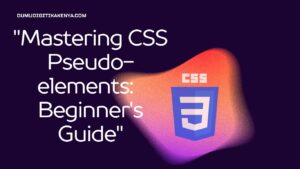Beginner’s Guide to CSS Forms: Creating Stylish Web Forms
In the ever-evolving realm of web development, crafting visually appealing and user-friendly forms is an indispensable skill. Welcome to our comprehensive guide on CSS Forms – your gateway to mastering the art of form design and styling. In this SEO-optimized tutorial, we will unravel the intricacies of CSS Forms, ensuring that you can create stunning web forms with ease. Whether you’re a beginner venturing into the world of web development or an experienced developer looking to refine your form-building skills, this guide will equip you with the knowledge and techniques you need to create forms that seamlessly blend functionality and aesthetics.
Why CSS Forms Matter: CSS (Cascading Style Sheets) empowers developers to transform dull and ordinary forms into engaging, interactive components of a website. From text inputs to checkboxes and submit buttons, CSS provides the tools to mold forms into visually captivating elements. Throughout this tutorial, we’ll navigate through the key components of form design, offering step-by-step guidance and real-world code examples. By the end of this tutorial, the focus keyword “CSS Forms” will be ingrained in your understanding, enabling you to craft web forms that not only gather data but also leave a lasting impression on users.
A Glimpse into the Journey Ahead: This guide will begin with the foundational HTML structure for forms, proceed with essential CSS styling, and delve into the intricacies of styling various form elements, including input fields, buttons, checkboxes, radio buttons, and select boxes. We’ll also explore the world of form validation and pseudo-classes, ensuring that your forms not only look great but also function flawlessly. By the end of this journey, you’ll possess the skills to create CSS Forms that are not only aesthetically pleasing but also user-friendly and responsive, making your websites stand out in today’s digital landscape. Let’s embark on this exciting adventure into the realm of CSS Forms together!

Table of Contents
1. HTML Structure for Forms
Before diving into CSS, let’s set up the HTML structure for a basic form:
<!DOCTYPE html>
<html>
<head>
<link rel="stylesheet" type="text/css" href="styles.css">
</head>
<body>
<form>
<!-- Form elements go here -->
</form>
</body>
</html>2. Basic CSS Styling
To style our form, create a separate CSS file (styles.css) and link it as shown in the HTML above. Let’s start with some basic styling:
/* styles.css */
form {
width: 300px;
margin: 0 auto;
padding: 20px;
border: 1px solid #ccc;
}3. Input Fields
Style text input fields:
input[type="text"] {
width: 100%;
padding: 10px;
margin-bottom: 10px;
border: 1px solid #ddd;
border-radius: 5px;
}4. Buttons
Style submit and reset buttons:
input[type="submit"], input[type="reset"] {
background-color: #007BFF;
color: #fff;
padding: 10px 20px;
border: none;
border-radius: 5px;
cursor: pointer;
}5. Checkboxes and Radio Buttons
Style checkboxes and radio buttons:
input[type="checkbox"], input[type="radio"] {
margin-right: 5px;
}6. Select Boxes
Style select dropdowns:
select {
width: 100%;
padding: 10px;
border: 1px solid #ddd;
border-radius: 5px;
}7. Validation and Pseudo-classes
Apply styles to input elements based on their states:
input:focus {
border-color: #007BFF;
outline: none;
}
input:invalid {
border-color: #FF0000;
}Summary
As we draw the curtains on our comprehensive guide to CSS Forms, you’ve embarked on a journey from novice to virtuoso in the art of web form design. The focus keyword “CSS Forms” has become synonymous with your newfound ability to craft visually stunning and highly functional web forms. Throughout this tutorial, we’ve equipped you with the knowledge and hands-on experience needed to create forms that elevate your web projects to new heights.
Empowering Design and Functionality: CSS Forms serve as a bridge between user interaction and web functionality. With a solid grasp of CSS, you now have the power to mold forms into engaging, user-friendly components that not only collect data but also create memorable user experiences. The journey began with establishing the HTML structure, ventured into the intricacies of CSS styling, and navigated through the styling nuances of various form elements. You’ve learned to apply form validation and pseudo-classes, ensuring that your forms not only look remarkable but also perform flawlessly.
Your CSS Forms Journey Continues: As you move forward in your web development journey, remember that CSS Forms are just the beginning. The skills and insights gained here are your foundation for crafting captivating user interfaces, whether it’s a simple contact form or a complex data-entry system. By mastering CSS Forms, you’ve positioned yourself to create websites that not only meet the functional requirements but also captivate and delight users. Keep experimenting, keep learning, and keep pushing the boundaries of what you can achieve with CSS Forms. Your journey to web development excellence has only just begun.



